Solar heating: 5 steps to save money on utility bills
Nowadays, various energy-saving technologies that use alternative and renewable energy sources are becoming more and more common in private construction. These include solar heating of a private house.
Having constructed such a system, you will be able to more than half reduce the cost of providing your home with heat during the cold season, and, perhaps, completely abandon the use of gas or solid fuel.
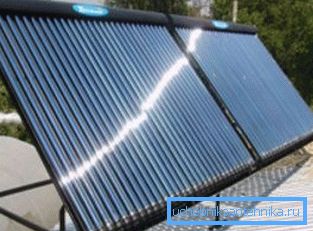
Installation of solar heating
Special features
Solar home heating systems have some features that you should be aware of before proceeding to their own production.
Let us dwell on the individual structural elements of this innovative engineering network and the nuances of their design:
- Solar heating of a country house, as the name implies, is carried out by ultraviolet rays sent by a day light. They illuminate specially made or purchased panels, which are a system of tubes placed in a special box, the upper part of which is transparent and exposed to sunlight.
In these collectors, the heat energy of the sun's rays is transferred to the coolant, which is water, antifreeze or air.
Note! With the help of solar heat exchangers can be equipped and heated greenhouses. However, it should be remembered that in most regions of Russia, such a system, working independently, is not able to provide the desired microclimate. It may be necessary to additionally include in the system a gas boiler or a heater for other types of fuel.
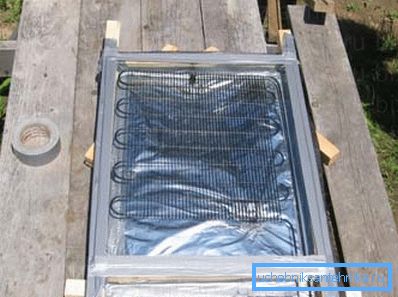
- Solar panels for heating can be made at home. The material for them will be metal pipes, welded in a special way into a closed system.
Required blanks in the following sizes:
- to supply cold and remove hot water - pipe size? inches and wall thickness of 1 mm;
- for the grille - pipes of smaller diameter and with thinner walls, allowing faster heat transfer.
It is possible to make solar water heaters for heating from 15–20 pipe lengths of 1.6–2 meters each.
- In order for the sun to be as efficient as possible, the manifold pipes must be placed in a specially designed wooden box. Its walls are made of a cut board 25 mm thick and long enough to enclose pipes in it (usually about 120-180 mm).
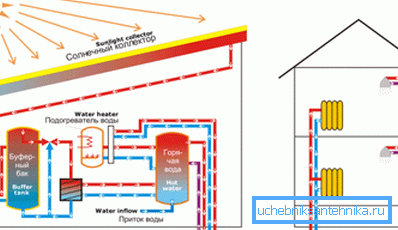
The bottom can be made of plywood, polycarbonate or hardboard. It can be additionally reinforced with wooden slats or in bars with a section of 30x30 mm.
But on this design box solar collector is not over. It is necessary to warm the structure, which will make solar heating even more efficient.
This is done as follows:
- the bottom of the box is covered with foam;
- the installed insulation is protected by a sheet of tin or galvanized;
- a pre-assembled radiator is mounted on it, which is fixed with the help of clamps or crown hoods.
Note! It is desirable to cover all internal parts of the box with black paint, which absorbs solar energy. In addition, care must be taken that the glass or transparent plastic covering the top is fastened as tightly as possible.
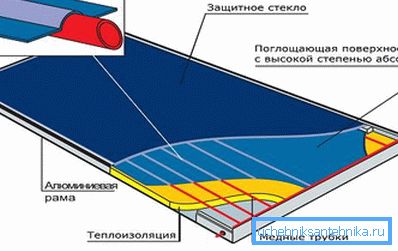
- The collector pipes are interconnected by threaded fittings. Take care of the tightness of the joints. Compaction can be done with hemp or special polymer tape. Also, before twisting the thread is recommended to miss the silicone sealant.
- Solar heating of the house provides for a tank in which water heated in the heat exchanger will accumulate.. This can be a metal or plastic tank, the walls of which are insulated with foam or other material having a low coefficient of thermal conductivity.
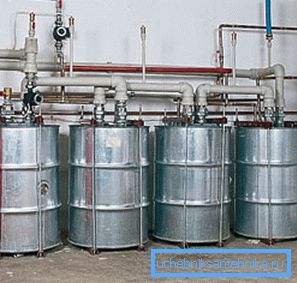
You can make a wooden box in which to place the water store, and fill the rest of the space with a heat insulator (expanded clay, foam, etc.).
The outer surface of the tank or box is preferably painted in silver, which will reduce heat loss and increase the efficiency of the designed system.
- Heating from the sun will only work if there is pressure in the pipes.. Therefore, it is necessary to install an avant-chamber - a sealed container with a volume of about 30 liters. It has a control valve that opens and closes the inlet.
Step-by-step assembly of the system
The assembly of the finished elements into a single system is simple and consists of 5 steps.
Step 1
A tank is installed that accumulates the water heated by the sun and the tank is responsible for maintaining the necessary pressure (avancamera). It needs to be fixed about 1-1.5 meters above the drive.
Step 2
Placed solar heat exchangers. The best place for them is on the south wall of the house or the roof. In the latter case, it is desirable to install the panels at an angle of 30-45 degrees to the horizon. In this case, solar heating systems will work more efficiently.

Step 3
Installed elements are connected with pipes.
It is advisable to use parts in two different sizes:
- ? inches - for the supply of water from the water supply system to the avancamera and the removal of water from solar heat exchangers (under pressure);
- 1-inch - for the remaining segments of the network.
All pipelines must be insulated. For this you can use ready-made shells of foamed polyethylene or basalt fiber.

Step 4
Heating - solar or any other - requires a heat carrier. Therefore, after the end of the assembly, the pipes should be filled with water. To do this, the design should provide refueling and drain valves, which are located at the bottom of the system.
Water supply should be stopped after it appears in the attic located in the attic.
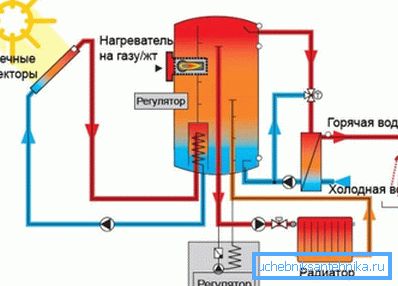
Step 5
The last stage is commissioning. To do this, simply open the supply valve. After that, the water level in the avancamera will decrease until the valve in it blocks the opening. By the way, this device can be used to control the water level.
The scheme of the solar heating
The functioning of the system is as follows. The water heated in the solar heat exchanger enters the storage tank, from where it can be transferred to heating radiators or hot water supply. In the latter case, the water is added to the system through the avankera.
With insufficient efficiency of the heating system, a gas boiler or another heater is connected to the circuit, which additionally heats the water in the tank.
Note! In addition to the scheme described above, there is solar air heating - it is somewhat easier to construct it with your own hands, however, the efficiency is much lower. Therefore, it is recommended to dwell on the above-described varieties with a heat transfer fluid.
Conclusion
The home-made solar heating of your home will not only save you money. That way you take care of the environment.
You can learn more information about energy-saving technologies that can be used in the construction of a country house from the video in this article.